Best Night Sky Events of December 2015 (Stargazing Maps)
Last Quarter Moon, December 2015
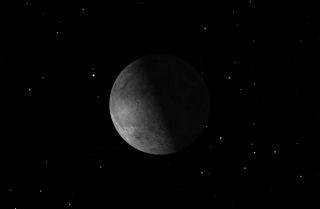
See what's up in the night sky for December 2015, including stargazing events and the moon's phases, in this Space.com gallery courtesy of Starry Night Software. SHOWN HERE: Thursday, Dec. 3, 2:40 p.m. EST. The Last Quarter Moon rises around 11:45 p.m. and sets around 1 p.m. It is most easily seen just after sunrise in the southern sky.
New Moon, December 2015

Friday, Dec. 11, 5:29 a.m. EST. The moon is not visible on the date of New Moon because it is too close to the sun, but can be seen low in the east as a narrow crescent a morning or two before, just before sunrise. It is visible low in the west an evening or two after New Moon.
First Quarter Moon, December 2015

Friday, Dec. 18, 10:14 a.m. EST. The First Quarter Moon rises around 12:30 p.m. and sets around 1 a.m. It dominates the evening sky.
Full Moon. December 2015
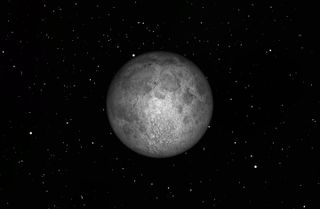
Friday, Dec. 25, 6:11 a.m. EST. The December Full Moon is known as the Oak Moon, Cold Moon or Long Nights Moon. It rises around sunset and sets around sunrise; this is the only night in the month when the moon is in the sky all night long. The rest of the month, the moon spends at least some time in the daytime sky.
Jupiter and the Moon, December 2015

Friday, Dec. 4, dawn. Jupiter will be 2 degrees north of the moon.
Venus and the Moon, December 2015
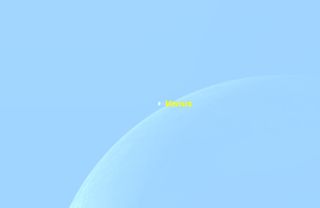
Monday, Dec. 7, morning. Venus will about a degree away from the moon at dawn. The moon will move to occult Venus over most of North America around noon EST, a good opportunity to locate Venus in the daytime sky.
Geminid Meteors, December 2015
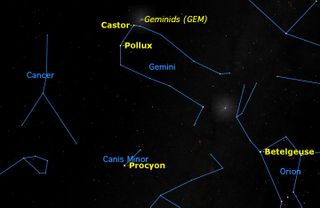
Monday–Tuesday, Dec. 14–15, midnight to dawn. The Geminid meteor shower, one of the most reliable in the year, peaks near midday on Dec. 14, so the best times to observe will be between midnight and dawn on the mornings of the 14th and 15th.
Get the Space.com Newsletter
Breaking space news, the latest updates on rocket launches, skywatching events and more!
Solstice, December 2015
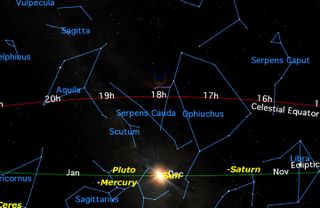
Monday, Dec. 21, 11:48 p.m. The sun reaches its southernmost declination for the year, resulting in the shortest day of the year in the northern hemisphere and the longest day of the year in the southern hemisphere.
Mercury at Greatest Eastern Elongation, December 2015
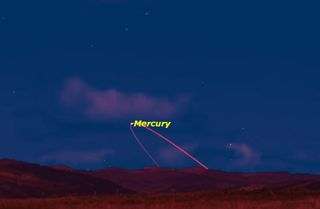
Tuesday, Dec. 29, dusk. Mercury will be well placed for observation in the western sky about half an hour after sunset.
Jupiter and the Moon, Dec. 30, 2015
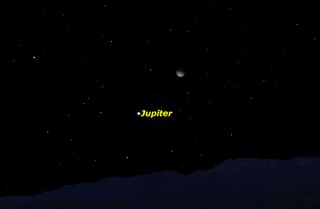
Wednesday, Dec. 30, before midnight. Jupiter and the moon are close in the sky, and rise together just before midnight.
Mercury, December 2015

Mercury is well placed low in the western sky at the end of the month.
Join our Space Forums to keep talking space on the latest missions, night sky and more! And if you have a news tip, correction or comment, let us know at: community@space.com.

Geoff Gaherty was Space.com's Night Sky columnist and in partnership with Starry Night software and a dedicated amateur astronomer who sought to share the wonders of the night sky with the world. Based in Canada, Geoff studied mathematics and physics at McGill University and earned a Ph.D. in anthropology from the University of Toronto, all while pursuing a passion for the night sky and serving as an astronomy communicator. He credited a partial solar eclipse observed in 1946 (at age 5) and his 1957 sighting of the Comet Arend-Roland as a teenager for sparking his interest in amateur astronomy. In 2008, Geoff won the Chant Medal from the Royal Astronomical Society of Canada, an award given to a Canadian amateur astronomer in recognition of their lifetime achievements. Sadly, Geoff passed away July 7, 2016 due to complications from a kidney transplant, but his legacy continues at Starry Night.

